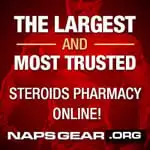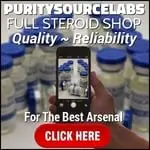microear said:
Hey everyone. I've been reading these posts for quite some time now. Thank you all for the interesting reading.
Let me give you all a quick summary. I am presently 29 years old. Aug '02 did my 1st 8 week cycle consisting of durateston and wistrol depot. Started at 175 lbs week 1 and finished gaining by the end of week 9 to a max of 219. Eventually settled down at 205. Not too bad I thought, very strict diet, (ate like a horse!) Ate pretty clean through the holidays with a little abuse of alcohol here and there over the holidays.
Jan 3 had blood work done and Jan 5 started an 8 week cycle of Winstrol Depot 100cc per day. Eating strict, no alcohol, no sodium no salt, no taste but as clean as anyone could do. Blood work came back on the 7th. Here are some of the results. Some great and others...? Should I quit? Should I continue? Any input would help.
Jan '02 Feb '97
AST 62
ALT 44
Cholesterol 148 181
HDL 18 44
LDL 110 117
LDL/HDL ratio 6.1
T3 Uptake 43
Whats up with this and how concerned should I be? Thanks in advance for all your input.
Your total came down to a good number, your HDL got A LOT worse and LDL got a little better but 110's not too shabby at all. But the problem is that an HDL of 18 is way too low bro.
It appears as though your total and LDL responded well to your dieting and the Winny did a number on your HDL. What bothers me is that after 2 months after being off your HDL is still only a measly 18.
Take a look at this info on Garlic from an old thread of mine. It appears from this that Garlic may be a good addition to a cycle containing Winny to help offset the lower HDL until it comes back up after the Winny is finsihed.
At least that's how I see it.
...........
I found this in this months (12/02) LEF publication at
www.lef.org
Is Conventional Medicine Finally Catching Up?
...A few pages later in this same issue of JAMA, a startling new finding showed that garlic prevents arterial occlusion by the same mechanism as HDL-cholesterol.2,3,4 Previous studies demonstrated that garlic protects against arteriosclerosis, but it was not clear how it does so 5-11
One way arterial occlusion occurs is when LDL-cholesterol binds with molecules secreted from the inner lining of the artery, forming tiny plaques that can accumulate and harden. HDL-cholesterol inhibits this process by absorbing excess plaque-forming molecules.12,13
According to the JAMA report, garlic extract works the same way as HDL cholesterol, but more potently. The researchers who conducted the study stated that, in concentrations relative to man, "garlic extract was 2.5 times more effective in inhibiting plaque formation than was HDL-cholesterol."
What the JAMA authors did not discuss was the positive impact that high-HDL confers on longevity. A common trait of people living to age 100 is high levels of HDL-cholesterol in their blood.14 It is not easy, however, to significantly elevate HDL levels. Even with the proper drugs and supplements, it is extremely difficult to raise HDL more than 27%. In some people, it is hard to get HDL levels to nudge upward at all. The fact that garlic extract was shown to be 2.5 times more effective in inhibiting arterial plaque formation than HDL represents a potential breakthrough in the prevention of the most common disease afflicting civilized man, i.e. plugged-up arteries.
The JAMA editors cautioned against supplementing with garlic because the potencies of active constituents vary so greatly between brands. Life Extension does not agree with this position based upon the fact that standardized aged-garlic extract under the Kyolic brand name is readily available to consumers. Previous studies confirm the protective effect of Kyolic garlic extract on the arterial wall.5,8
The best news is that the Kyolic company has finally come out with a high-potency caplet that enables most people to swallow just one a day to obtain 1000 mg of standardized aged garlic extract. For more than a decade, Life Extension had asked the makers of Kyolic for a high-potency supplement so that users would not have to swallow so many capsules. Based on the research reports we have reviewed, it would appear that one 1000 mg Kyolic caplet should be taken for every 1.1 pounds of food eaten a day...
For longer life,
William Faloon
--------------------------------------------------------------------------------
References
1. JAMA, September 18, 2002, 288(11):1342.
2. Garlic Prevents Plaque, JAMA, September 18, 2002, 285(11): 1342.
3. Siegel, et. al., Effect of Garlic on Arteriosclerosis, presentation at NIH workshop on herbs and heart disease, August 2002.
4. Siegel, G., A Primary Lesion Model for Arteriosclerosis Microplaque Formation, Int. J. Angiol, 2000, 9: 129-134.
5. Efendy et.al., The Effect of the Aged Garlic Extract, 'Kyolic', on the Development of Experimental Atheriosclerosis, Atherosclerosis, 1997, 132: 37-42.
6. Fogarty, M., Garlic's Potential Role in Reducing Heart Disease, BJCP, March/April 1993, 47(2): 64-65.
7. Campbell, JH et. al., Molecular Basis By Which Garlic Suppresses Atherosclerosis, J. of Nutrition, March 2001 Suppl, 131(3S): 1006S-1009S.
8. Borek, Antioxidant Health Effects of Aged Garlic Extract, J. of Nutrition, March 2001 Suppl., 131(3S): 1010S-1015S.
9. Lau, Benj., Suppression of LDL Oxidation by Garlic, J. of Nutrition, March 2001 Suppl., 131(3S): 985S-988S.
10. Slowing et. al., Study of Garlic Extracts and Fractions on Cholesterol-Fed Rats, J. of Nutrition, March 2001 Suppl., 131(3S): 994S-999S.
11. Ho et. al., S-Allyl Cysteine Reduces Oxidant Level in Cells Involved in the Atherogenic Process, Phytomedicine, 2001, 8(1): 39-46.
12. Harrison's Principles of Internal Medicine, 15th ed., 2001, The Pathogenesis of Atherosclerosis, 1377-1382.
13. Stein, et. al., Internal Medicine, 1988, 1889.


 Please Scroll Down to See Forums Below
Please Scroll Down to See Forums Below 










